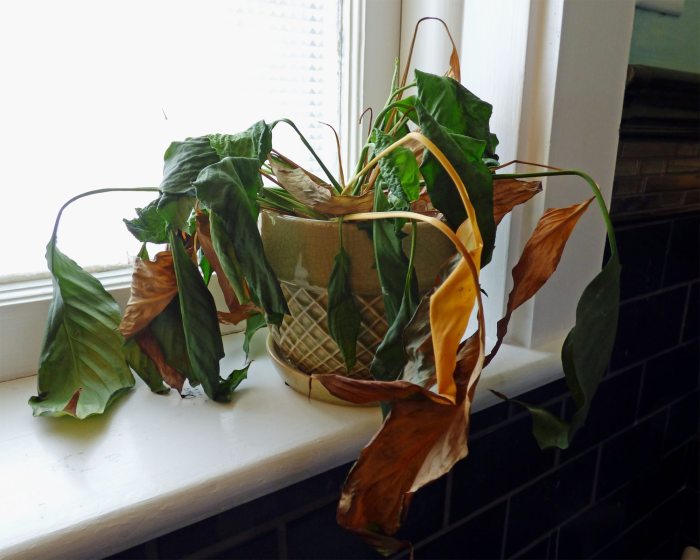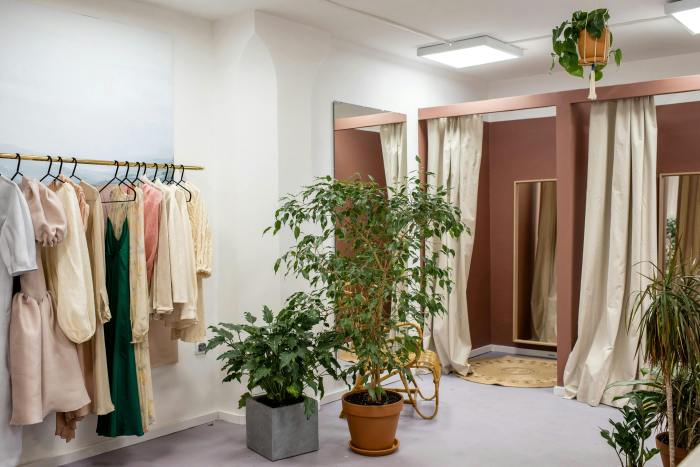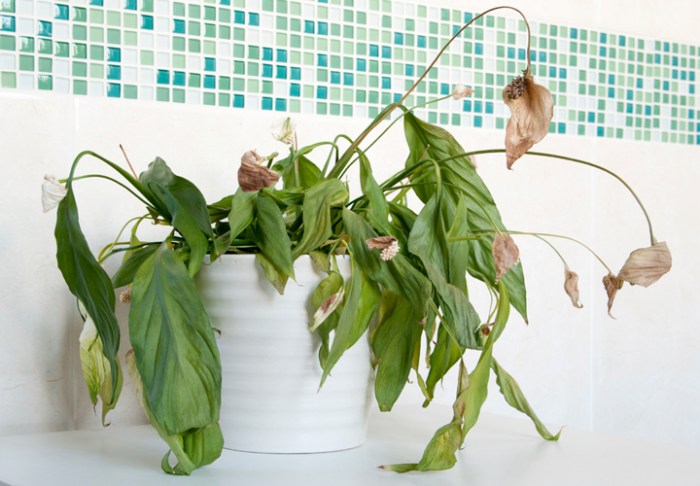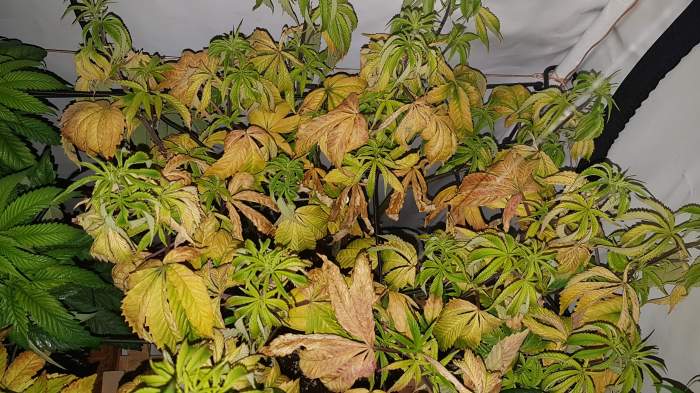Why are my hanging plants dying? This question plagues many plant enthusiasts who adore the beauty and tranquility that hanging plants bring to their homes. In this comprehensive guide, we delve into the intricate world of hanging plant care, uncovering the secrets to keeping these aerial wonders thriving and vibrant.
From understanding their specific environmental needs to mastering proper watering techniques, this guide equips you with the knowledge and strategies to diagnose and address any issues that may be affecting your hanging plants.
Environmental Factors

Hanging plants rely on their environment for optimal growth and well-being. Understanding their specific needs for light, temperature, and humidity is crucial to prevent premature decline or death.
Light Requirements
Most hanging plants prefer bright, indirect light. Direct sunlight can scorch leaves, while low light levels can stunt growth. Assess the natural light conditions in your space and choose plants that suit the available light intensity.
Temperature and Humidity
Hanging plants generally thrive in warm, humid environments. Ideal temperatures range from 60 to 80 degrees Fahrenheit (15 to 27 degrees Celsius). Dry air can cause leaves to brown and curl, so consider using a humidifier or misting the plants regularly.
Environmental Stress Manifestations:
If you’re wondering why your hanging plants are dying, it could be because they’re not getting the right care. Make sure they’re getting enough light, water, and nutrients. If you’re not sure what kind of hanging plants are safe for your dog, check out this list . Some common safe options include spider plants, ferns, and air plants.
Once you’ve ruled out any other potential causes, you can start to troubleshoot the problem.
- Yellowing or wilting leaves: insufficient light
- Scorched leaves: excessive sunlight
- Brown or curling leaves: low humidity
- Stunted growth: insufficient light or temperature
Water Management
Maintaining adequate hydration is crucial for the well-being of hanging plants. Understanding their specific watering requirements and avoiding extremes is essential for their optimal growth.
Overwatering can lead to root rot, fungal infections, and yellowing of leaves. Conversely, underwatering causes wilting, brown leaf tips, and stunted growth. Determining the optimal watering schedule depends on factors such as plant species, pot size, and environmental conditions.
One of the reasons why your hanging plants might be dying is due to insufficient sunlight. If your hanging plants are not getting enough sunlight, they may start to wilt and die. One way to fix this is to move your plants to a brighter location.
If you don’t have a brighter location, you can also try using a grow light. You can find more information about hanging air plants at hanging air plants bunnings . Another reason why your hanging plants might be dying is due to overwatering.
If you water your plants too often, the roots can become waterlogged and start to rot. To avoid this, only water your plants when the soil is dry to the touch.
Watering Techniques
- Water thoroughly until excess water drains from the drainage holes.
- Allow the soil to dry out slightly between waterings, preventing waterlogging.
- Use room-temperature water to avoid shocking the plant.
Determining Watering Schedule
- Observe the plant’s leaves: Wilting or yellowing indicates underwatering, while waterlogged soil or brown leaf tips suggest overwatering.
- Check the soil moisture: Insert a finger or a moisture meter into the soil to determine its dryness.
- Consider the plant’s species: Some plants, like succulents, require less frequent watering than others.
- Adjust watering frequency based on environmental factors: Higher temperatures and lower humidity require more frequent watering.
Nutrient Deficiency

Nutrient deficiencies can occur when hanging plants do not receive the essential nutrients they need for optimal growth and health. These deficiencies can manifest in various ways, affecting the plant’s appearance, growth patterns, and overall well-being.
Common nutrient deficiencies in hanging plants include:
- Nitrogen deficiency: Nitrogen is essential for plant growth and development. Its deficiency can lead to stunted growth, yellowing leaves, and poor flowering.
- Phosphorus deficiency: Phosphorus is vital for root development and energy production. Its deficiency can cause stunted growth, weak roots, and poor flowering.
- Potassium deficiency: Potassium is crucial for water regulation and photosynthesis. Its deficiency can result in weak stems, brown leaf tips, and poor overall growth.
- Magnesium deficiency: Magnesium is necessary for chlorophyll production and photosynthesis. Its deficiency can cause yellowing leaves with green veins, stunted growth, and poor flowering.
- Calcium deficiency: Calcium is essential for cell division and root development. Its deficiency can lead to stunted growth, weak roots, and poor flowering.
Addressing Nutrient Deficiencies, Why are my hanging plants dying
Addressing nutrient deficiencies in hanging plants involves identifying the specific nutrient lacking and providing the necessary supplementation. This can be done through:
- Fertilizing: Fertilizers provide essential nutrients to plants. Choose a balanced fertilizer specifically designed for hanging plants and follow the instructions for application.
- Soil amendments: Adding organic matter, such as compost or manure, to the soil can improve nutrient availability and soil health.
- Foliar feeding: Spraying a diluted fertilizer solution directly onto the leaves can provide a quick boost of nutrients.
It is important to avoid over-fertilizing, as this can lead to nutrient burn and damage the plant. Regular monitoring of the plant’s health and nutrient levels is essential to ensure optimal growth and prevent deficiencies.
Pests and Diseases
Hanging plants are susceptible to various pests and diseases that can hinder their growth and vitality. These infestations can manifest through visible symptoms such as discoloration, wilting, or stunted growth. It is crucial to identify and address these issues promptly to prevent further damage and ensure the well-being of the plants.
Prevention
Regular inspection of hanging plants is essential for early detection of potential infestations. Maintaining proper plant care practices, such as providing adequate sunlight, water, and nutrients, can also help strengthen the plants’ natural defenses against pests and diseases. Additionally, isolating infected plants can prevent the spread of infestations to healthy ones.
Treatment
If an infestation is identified, prompt action is necessary to eradicate the problem and minimize damage to the plant. Chemical pesticides or insecticidal soaps can be used to control pests, while fungicides can be effective against fungal diseases. However, it is important to follow the manufacturer’s instructions carefully to ensure safe and effective application.
In some cases, severely infected plants may need to be removed to prevent the spread of disease.
Common Pests
Aphids, mealybugs, and spider mites are common pests that can infest hanging plants. These insects feed on plant sap, causing yellowing, wilting, and stunted growth. Aphids are small, soft-bodied insects that can be green, black, or red, while mealybugs appear as white, cottony masses on the stems and leaves.
Spider mites are tiny, spider-like creatures that spin webs on the undersides of leaves.
If you’re wondering why your hanging plants are dying, you may need to consider artificial hanging plants. Artificial hanging plants bunnings can be a great way to add greenery to your home without the worry of keeping them alive. With a variety of styles and materials to choose from, you’re sure to find the perfect artificial hanging plant to suit your needs.
Common Diseases
Powdery mildew, botrytis, and root rot are common diseases that can affect hanging plants. Powdery mildew appears as a white, powdery substance on the leaves, while botrytis causes brown, water-soaked lesions on the stems and flowers. Root rot is caused by excessive moisture in the soil, leading to the decay of the plant’s roots and subsequent wilting and yellowing of the leaves.
Plant Selection

Selecting the right plants for hanging baskets is crucial to their success. Consider factors like size, growth habit, and light requirements to ensure optimal growth and aesthetics.
Small to medium-sized plants with trailing or cascading growth habits are ideal for hanging baskets. They create a lush, overflowing effect without becoming too heavy or overgrown.
Suitable Plant Recommendations
- Trailing Petunias:Vibrant, heat-tolerant flowers that cascade beautifully.
- Ivy Geraniums:Hardy, trailing plants with glossy leaves and colorful blooms.
- Trailing Lobelia:Delicate, airy plants with small, vibrant flowers.
- Bacopa:Trailing plants with small, star-shaped flowers in various colors.
- Ferns:Shade-loving plants that add a touch of greenery and texture.
Epilogue: Why Are My Hanging Plants Dying

By understanding the factors that contribute to hanging plant health, you can create an optimal environment for your leafy companions to flourish. Whether you’re a seasoned plant parent or just starting your journey, this guide will empower you to provide the best possible care for your hanging plants, ensuring they continue to grace your home with their beauty and tranquility.
Essential FAQs
Why are the leaves on my hanging plant turning yellow?
Yellowing leaves can indicate nutrient deficiencies, overwatering, or insufficient light.
Why are the stems of my hanging plant becoming brown and mushy?
Brown and mushy stems are often a sign of overwatering or root rot.
Why are there small insects crawling on my hanging plant?
Small insects may indicate a pest infestation. Common pests include aphids, mealybugs, and spider mites.